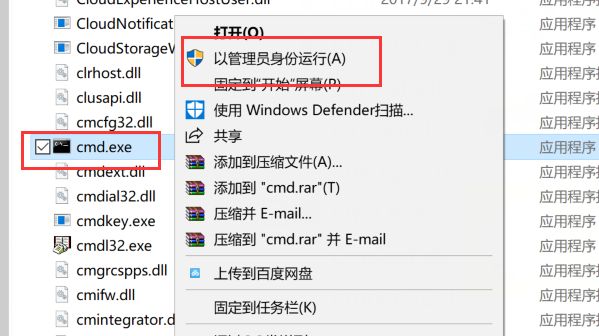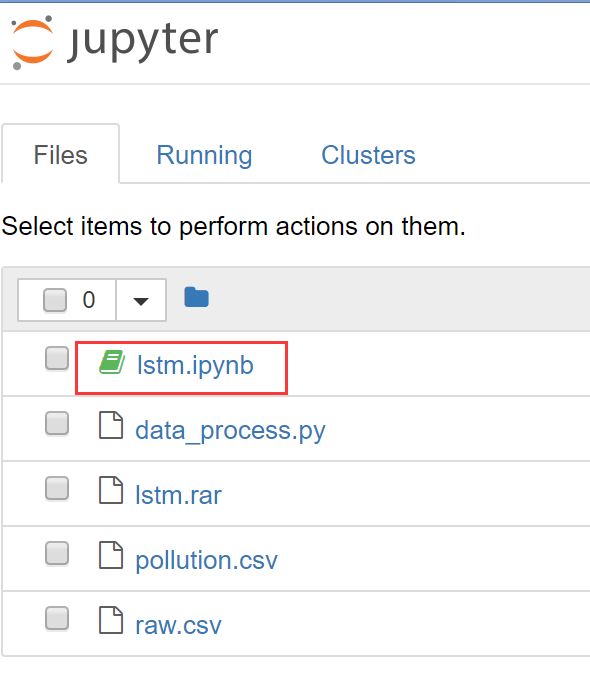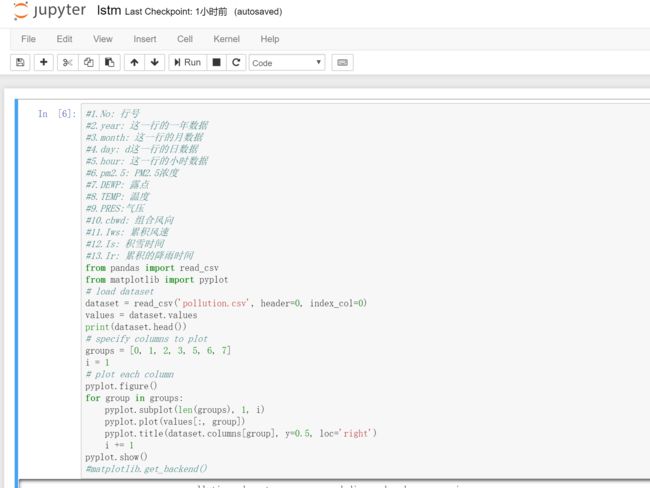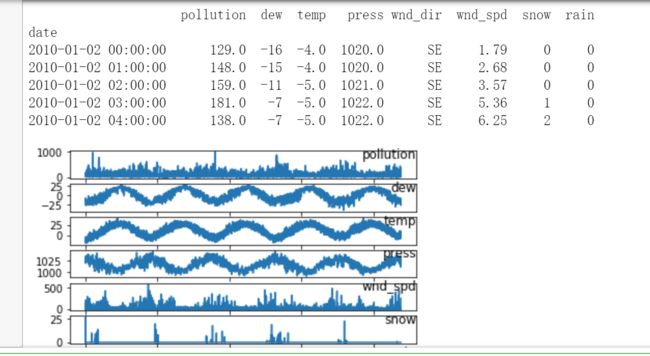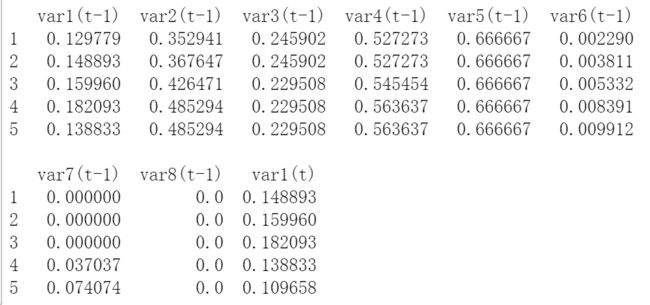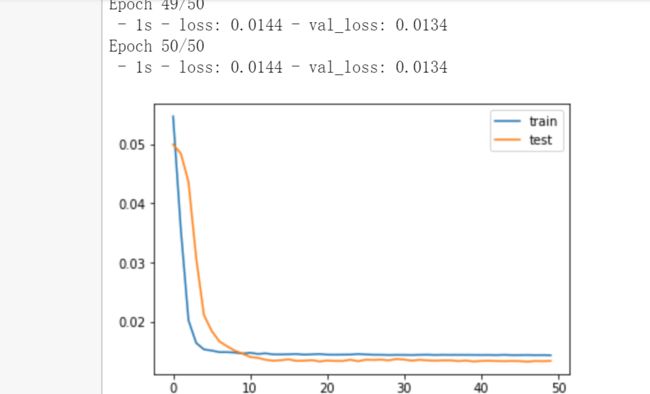安装python工具包
找到C:\Windows\system32\cmd 右键 以管理员身份运行
有些包需要管理员权限才能安装
pip3 install --upgrade tensorflow (机器学习框架)
pip3 install --upgrade pandas (数据处理用的)
pip3 install --upgrade keras (机器学习封装框架,可基于tensorflow)
pip3 install --upgrade sklearn (特征工程+模型训练)
pip3 install --upgrade matplotlib (画图)
pip3 install --upgrade jupyter (学习好帮手)
ps:有lstm.rar的同学可走捷径,可走特殊照顾渠道,使用juypter notebook 查看代码
1、解压lstm.rar 到lstm
2、win+r cmd 到lstm目录
3、输入 jupyter notebook
会默认帮你打开浏览器
打开此文件,文章下面的东西在此界面都可查看并直接运行
空气污染预报
在本教程中,我们将使用空气质量数据集。
这是一个数据集,在美国驻北京的大使馆五年内每小时报告天气和污染水平。
数据包括日期时间, PM2.5污染物,以及天气信息,包括露点、温度、气压、风向、风速以及降雨和降雪的累积小时数。原始数据中的完整功能列表如下:
1.No: 行号
2.year: 这一行的一年数据
3.month: 这一行的月数据
4.day: d这一行的日数据
5.hour: 这一行的小时数据
6.pm2.5: PM2.5浓度
7.DEWP: 露点
8.TEMP: 温度
9.PRES:气压
10.cbwd: 组合风向
11.Iws: 累积风速
12.Is: 积雪时间
13.Ir: 累积的降雨时间
我们可以使用这些数据并构建一个预测问题,鉴于天气条件和前几个小时的污染,我们预测下一个小时的污染。
你可以从UCI Machine Learning Repository下载数据集。传送门坏了。。。。
•北京PM2.5数据集
下载数据集并将其放在你当前的工作目录中,文件名为“raw.csv”。
处理基础数据
第一步是将日期时间信息整合到一个单独的日期时间,以便我们可以将其用作Pandas的索引。
快速检查显示前24小时pm2.5的NA值。 因此,我们需要删除第一行数据,在数据集中还有几个分散的“NA”值; 我们现在可以用0值标记它们。或者用fillna来填充你需要的值。
以下脚本加载原始数据集,并将日期时间信息解析为Pandas DataFrame索引。No列被删除,然后为每列指定更清晰的名称。最后,将NA值替换为“0”值,并删除前24小时。
from pandas import read_csv
from datetime import datetime
# load data
def parse(x):
return datetime.strptime(x, '%Y %m %d %H')
dataset = read_csv('raw.csv', parse_dates = [['year', 'month', 'day', 'hour']], index_col=0, date_parser=parse)
dataset.drop('No', axis=1, inplace=True)
# manually specify column names
dataset.columns = ['pollution', 'dew', 'temp', 'press', 'wnd_dir', 'wnd_spd', 'snow', 'rain']
dataset.index.name = 'date'
# mark all NA values with 0
dataset['pollution'].fillna(0, inplace=True)
# drop the first 24 hours
dataset = dataset[24:]
# summarize first 5 rows
print(dataset.head(5))
# save to file
dataset.to_csv('pollution.csv')
将数据集保存到“pollution.csv”。
查看数据
from pandas import read_csv
from matplotlib import pyplot
# load dataset
dataset = read_csv('pollution.csv', header=0, index_col=0)
values = dataset.values
print(dataset.head())
# specify columns to plot
groups = [0, 1, 2, 3, 5, 6, 7]
i = 1
# plot each column
pyplot.figure()
for group in groups:
pyplot.subplot(len(groups), 1, i)
pyplot.plot(values[:, group])
pyplot.title(dataset.columns[group], y=0.5, loc='right')
i += 1
pyplot.show()
dataset.head(5)
空气污染时间序列线图
多变量LSTM预测模型
清洗数据,将数据集视为监督学习问题并对输入变量进行归一化
from sklearn.preprocessing import MinMaxScaler
from sklearn.preprocessing import LabelEncoder
from pandas import read_csv
from pandas import DataFrame
from pandas import concat
# convert series to supervised learning
def series_to_supervised(data, n_in=1, n_out=1, dropnan=True):
n_vars = 1 if type(data) is list else data.shape[1]
df = DataFrame(data)
cols, names = list(), list()
# input sequence (t-n, ... t-1)
for i in range(n_in, 0, -1):
cols.append(df.shift(i))
names += [('var%d(t-%d)' % (j+1, i)) for j in range(n_vars)]
# forecast sequence (t, t+1, ... t+n)
for i in range(0, n_out):
cols.append(df.shift(-i))
if i == 0:
names += [('var%d(t)' % (j+1)) for j in range(n_vars)]
else:
names += [('var%d(t+%d)' % (j+1, i)) for j in range(n_vars)]
# put it all together
agg = concat(cols, axis=1)
agg.columns = names
# drop rows with NaN values
if dropnan:
agg.dropna(inplace=True)
return agg
# load dataset
dataset = read_csv('pollution.csv', header=0, index_col=0)
values = dataset.values
# integer encode direction
encoder = LabelEncoder()
values[:,4] = encoder.fit_transform(values[:,4])
# ensure all data is float
values = values.astype('float32')
# normalize features
scaler = MinMaxScaler(feature_range=(0, 1))
scaled = scaler.fit_transform(values)
# frame as supervised learning
reframed = series_to_supervised(scaled, 1, 1)
# drop columns we don't want to predict
reframed.drop(reframed.columns[[9,10,11,12,13,14,15]], axis=1, inplace=True)
print(reframed.head())
运行示例打印转换后的数据集的前5行。我们可以看到8个输入变量(输入序列)和1个输出变量(当前小时的污染水平)
将数据集分成训练集和测试集
# split into train and test sets
values = reframed.values
n_train_hours = 365 * 24
train = values[:n_train_hours, :]
test = values[n_train_hours:, :]
# split into input and outputs
train_X, train_y = train[:, :-1], train[:, -1]
test_X, test_y = test[:, :-1], test[:, -1]
# reshape input to be 3D [samples, timesteps, features]
train_X = train_X.reshape((train_X.shape[0], 1, train_X.shape[1]))
test_X = test_X.reshape((test_X.shape[0], 1, test_X.shape[1]))
print(train_X.shape, train_y.shape, test_X.shape, test_y.shape)
定义并配置LSTM模型
我们将在第一个隐藏层中定义具有50个神经元的LSTM以及输出层中用于预测污染的的1个神经元。输入形式将是一个时间具有8个特征的步长。
我们将使用平均绝对误差(MAE)损失函数和随机梯度下降的高效Adam版本。
该模型将配置为适用于50个批量大小为72的训练周期。
最后,我们通过在fit()函数中设置validation_data参数来跟踪训练过程中的训练和测试损失,然后在运行结束时,绘制训练和测试损失曲线图。
from numpy import concatenate
from keras.models import Sequential
from keras.layers import Dense
from keras.layers import LSTM
from matplotlib import pyplot
# design network
model = Sequential()
model.add(LSTM(50, input_shape=(train_X.shape[1], train_X.shape[2])))
model.add(Dense(1))
model.compile(loss='mae', optimizer='adam')
# fit network
history = model.fit(train_X, train_y, epochs=50, batch_size=72, validation_data=(test_X, test_y), verbose=2, shuffle=False)
# plot history
pyplot.plot(history.history['loss'], label='train')
pyplot.plot(history.history['val_loss'], label='test')
pyplot.legend()
pyplot.show()
评估模型
from math import sqrt
from sklearn.metrics import mean_squared_error
# make a prediction
yhat = model.predict(test_X)
test_X = test_X.reshape((test_X.shape[0], test_X.shape[2]))
# invert scaling for forecast
inv_yhat = concatenate((yhat, test_X[:, 1:]), axis=1)
inv_yhat = scaler.inverse_transform(inv_yhat)
inv_yhat = inv_yhat[:,0]
# invert scaling for actual
test_y = test_y.reshape((len(test_y), 1))
inv_y = concatenate((test_y, test_X[:, 1:]), axis=1)
inv_y = scaler.inverse_transform(inv_y)
inv_y = inv_y[:,0]
# calculate RMSE
rmse = sqrt(mean_squared_error(inv_y, inv_yhat))
print('Test RMSE: %.3f' % rmse)
pyplot.figure()
pyplot.subplot(2, 1, 1)
pyplot.plot(yhat[:,0],"b--",linewidth=1,color="red")
pyplot.subplot(2, 1, 2)
pyplot.plot(test_X[:, 0],"b--",linewidth=1)
pyplot.show()
